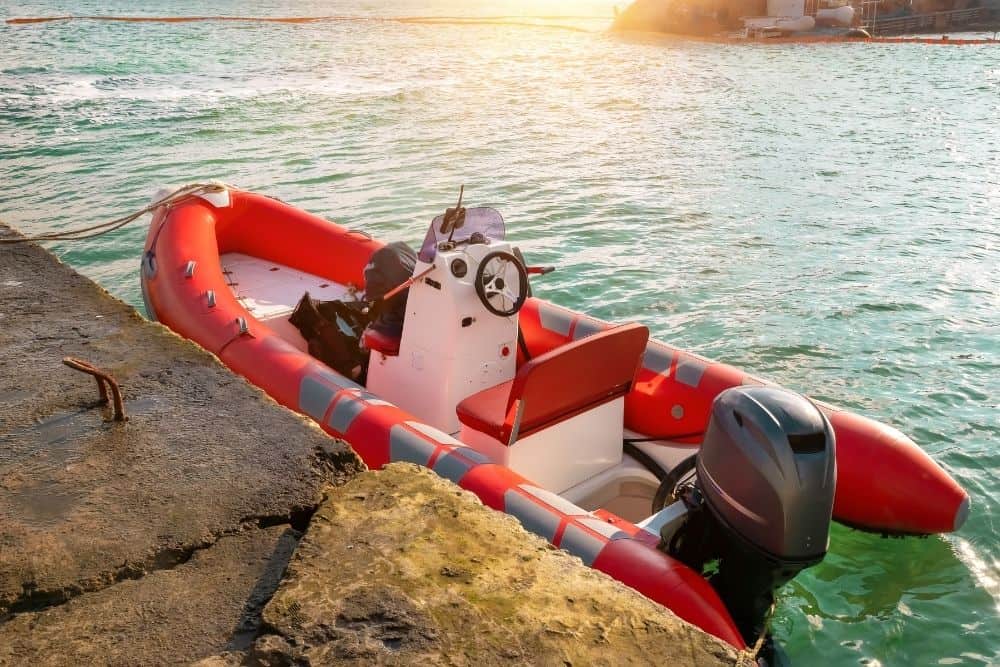With any boat, it’s important to balance the weight on the boat so that it floats easily. This is especially true of inflatable boats.
Most larger boats are already somewhat balanced in the way they are designed. But inflatable boats are generally small, lightweight, and have relatively low weight capacities. For this reason, it is especially important to balance the weight, or you may find your boat tipping over.
But how serious do you have to be about balancing your boat, really? What are some of the benefits of doing it correctly?
And how do you do it in the first place?
Keep reading!
In this article, we’ll discuss all of these questions.
Table of Contents
What are the Benefits of Balancing an Inflatable Boat?

As mentioned in the introduction, most inflatable boats are small and lightweight. They can only support so much weight, and even if you’ve got it all balanced perfectly, if you approach or exceed the weight maximum, you will find yourself riding low and may take on water.
Now, imagine if most of your weight is stowed on one side of the boat, or near the bow or stern. The weight will cause that part of the boat to ride even lower, which may allow it to take on even more water and, eventually, will cause it to capsize.
Balancing the weight in your boat allows you to carry more weight without risking the stability of the boat. (That said, you should never carry more than the specified weight limit for your boat).
Some of the most notable benefits of balancing the weight in your boat are noted below.
- You can haul an appropriate amount of gear and passengers safely, without risking a capsize every time someone shifts their position a little bit.
- The boat will feel more stable, which will probably result in added peace of mind for you and your passengers.
- You will avoid putting undue stress on any one area of the boat, which in turn may prevent damage and cause the boat to last longer.
- The boat will move more efficiently through the water, allowing you to travel farther with less effort (or less of a strain on your trolling motor).
So as you can see, there are a number of reasons to balance your boat correctly. But how do you do that?
How Do You Balance an Inflatable Boat?

Boats have two different “centers” that determine how they float: a center of buoyancy, or CB, and a center of gravity, or CG. The CB and CG will always align vertically when the boat is in the water.
How does that apply to balancing your boat?
If your boat’s CB and CG are properly aligned, the boat will be in balance and will float evenly.
If the CB and CG are not aligned, they will align themselves once the boat is in the water, which may cause it to list to one side or cause the bow or stern to sink further down in the water than it should. In other words, the boat may float unevenly.
So, when balancing your boat, what you’re really doing is getting the CB and CG to align ahead of time so they don’t throw your boat off-kilter once you’re in the water.
But what does that mean, practically speaking? How do you make sure everything is in alignment so that your boat balances properly?
There are a few things you can do.
Evenly Distribute Heavy Equipment

Even in an inflatable boat, you may have equipment such as trolling motors and their batteries, fish finders, and depth detectors. If at all possible, these pieces of equipment should be spread out around the boat.
The weight of each object will determine how close or far it should be in relation to the boat’s center of CB and CG. For most boats, the CB and CG will be about two-thirds back from the bow, however, you’ll want to refer to your owner’s manual for the specifics of your boat.
Some objects may need to be mounted in a certain spot. For example, many inflatable boats have rigid transoms for mounting trolling motors on the stern. So, say the trolling motor weighs 10 pounds, and its battery, also near the stern, weighs 20 pounds.
That’s 30 pounds of equipment near the stern. To balance it out, you’ll want to place another 30 pounds of equipment or gear toward the bow, an equal distance from the CG.
Alternately, you could place 15 pounds of equipment twice as far from the center of gravity, or 60 pounds at half the distance.
Your owner’s manual may include information on the boat’s center of gravity and how to distribute the weight, or you can check out this article for more detailed information on calculating where to put your equipment.
The main thing to understand is that various pieces of equipment will add a significant amount of weight to your inflatable boat. It’s important to plan accordingly and space it out around the boat so it doesn’t throw off the CB and CG alignment.
Evenly Distribute Any Gear You’re Hauling

This is also true of the gear you take with you. The exact type and weight of gear may change from trip to trip, or you may keep it fairly consistent. You may be hauling fishing supplies, coolers, packs of non-perishable snacks or first aid supplies, tools, or camping gear.
Regardless of what you have with you, it’s important not to store it all in one place on your boat. While it isn’t necessary to weigh each item and figure out exactly where it should be kept, it’s a good idea to understand approximate weights and spread things out accordingly.
Also take into account any mounted equipment as discussed in the previous section. If you’ve got 30 pounds of gear at the stern, you probably won’t want to stow 30 additional pounds of gear in the same spot unless the weight balances out in the bow.
Spread everything out so that no one part of the boat is weighed down with extra equipment or supplies.
Sit in the Appropriate Spots

This may seem obvious, but it’s especially important if you’re hauling a lot of extra gear and you have multiple passengers. Larger individuals should be spread out around the center of gravity, and everyone should sit in the designated seats in the boat.
Again, consider the weight and placement of your gear and equipment, but keep in mind that you and your passengers will likely make up the largest amount of weight in the boat. Spread yourselves out accordingly, and try not to move around too much.
Conclusion
Balancing your inflatable boat is extremely important to ensure you have a safe and enjoyable day on the water. Understanding your center of buoyancy and center of gravity will help you know how to space your gear, equipment, and passengers in the safest way possible.
Happy boating!

Sarah Hood has been writing for Anchor Travel since 2021. When she’s not writing, she enjoys cooking, singing, and spending time in the great outdoors.

